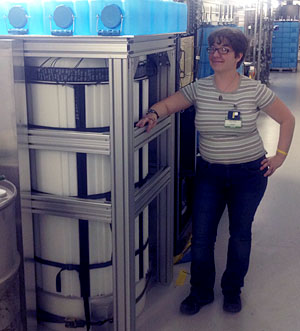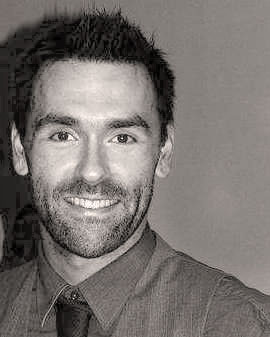 |
 |
 |
 |
 |
 |
 |
 |
 |
 |
|
KICP Workshops & Events
|
PhD Thesis Defenses, 2014 Eric Baxter, "Measuring Gravitational Lensing of the Cosmic Microwave Background by Galaxy Clusters" July 18, 2014 | 11:00 AM | TAAC 67 Scientific Advisor: Scott Dodelson Related Links: KICP Members: Scott Dodelson KICP Students: Eric J. Baxter Nicole Fields, "CosI: Development of a Low Threshold Detector for the Observation of Coherent Elastic Neutrino-Nucleus Scattering" October 8, 2014 | 4:00 PM | ACC 211  PhD Committee Members: Juan Collar, Paolo Privitera, Carlos Wagner, David Biron "Nicole's thesis describes the development of a detector capable of measuring the process of coherent elastic scattering of neutrinos off nuclei. This is the same process expected to mediate dominant interactions from WIMP dark matter candidates. First proposed 40 years ago, it hasn't been experimentally confirmed yet. Nicole's thesis discusses a full feasibility study with a prototype, and the installation of the detector at the SNS source in Oak Ridge National Laboratory". - Juan I. Collar, PhD advisor Thesis Abstract: I present the development of an experimental setup designed to measure CENNS (coherent elastic neutrino-nucleus scattering), a process that has never been experimentally observed. CosI (Coherent Neutrino Scattering with Cesium Iodide) uses a sodium doped cesium iodide detector intended to be able to observe CENNS at the SNS (Spallation Neutron Source) in Oak Ridge, TN. This thesis describes the experimental design and construction of the CosI apparatus, while sited at the University of Chicago. This thesis also presents the screening of materials for radioactivity in conjunction with simulations of the background contributions from various experimental components to CosI. Background measurements were performed at the University of Chicago with a 2 kg prototype CosI crystal, and those results are presented here. I also present neutrino signal calculations for the full size 15 kg CosI crystal which is to be installed at the SNS. Finally, the feasibility of a CENNS detection at the SNS using the CosI apparatus is discussed. This thesis also makes a contribution to the ongoing search for WIMP (weakly interacting massive particle) dark matter. I present a data-driven method for applying a surface event correction to CoGeNT (Coherent Germanium Neutrino Technology) data. After applying this correction, I then calculate new dark matter limits using the 807 day CoGeNT data set. In addition, I also perform a two dimensional maximum likelihood analysis of low energy CDMS (Cryogenic Dark Matter Search) data. The maximum likelihood analysis reveals a strong preference for a population of nuclear recoil events in the CDMS data set. Related Links: KICP Members: Juan I. Collar; Paolo Privitera; Carlos E. M. Wagner KICP Students: Nicole Fields Scientific projects: Coherent Germanium Neutrino Technology (CoGeNT) Alan Zablocki, "Constraining Neutrinos and Dark Energy with the Angular Clustering of Galaxies in the Dark Energy Survey" November 11, 2014 | 12:00 PM | TAAC 67  PhD Committee members: Joshua A. Frieman, Scott Dodelson, Wayne Hu, Don York "Over the last decade, cosmological observations have placed increasingly stringent upper bounds on the masses of neutrinos, while observations of neutrino oscillations imply a lower bound. Alan's thesis provides a detailed forecast of the constraints that the Dark Energy Survey (DES) will be able to place on neutrino mass in the next few years, accounting for uncertainties in dark energy and in the relative amplitude of galaxy clustering. He finds that DES has a good chance of shedding light on the pattern of neutrino masses (the mass hierarchy), an exciting possibility. His results will be of broad interest to cosmologists." - Joshua A. Frieman, PhD advisor Thesis Abstract: We determine the forecast errors on the absolute neutrino mass scale and the equation of state of dark energy by combining synthetic data from the Dark Energy Survey (DES) and the Cosmic Microwave Background (CMB) Planck surveyor. We use angular clustering of galaxies for DES in 7 redshift shells up to $zsim 1.7$ including cross-correlations between different redshift shells. We study models with massless and massive neutrinos and three different dark energy models: lcdm ($w=-1$), wCDM (constant $w$), and waCDM (evolving equation of state parameter $w(a)=w_0 + w_{a}(1-a)$). We include the impact of uncertainties in modelling galaxy bias using a constant and a redshift-evolving bias model. For the $Lambda$CDM model we obtain the best upper limit for the sum of neutrino masses from DES+Planck of $Sigma m_ u < 0.08$ eV (95\% C.L.) for a fiducial mass of $Sigma m_ u = 0.047$ eV, assuming perfect knowledge of galaxy bias. For the wCDM model the limit is $Sigma m_ u < 0.10 $ eV. For a wCDM model where galaxy bias evolves with redshift the upper limit on the sum of neutrino masses increases to 0.19 eV. The upper limit on $Sigma m_ u$ does not change much when we allow $w$ to vary with redshift, once we include a redshift-evolving galaxy bias model, with a limit of $Sigma m_ u < 0.20$ eV. DES will be able to place competitive upper limits on the sum of neutrino masses of 0.1-0.2 eV and could therefore strongly constrain the inverted mass hierarchy of neutrinos. In a wCDM model the 1$sigma$ error on constant $w$ is $Delta w= 0.03$ from DES galaxy clustering and Planck. Allowing $Sigma m_ u$ as a free parameter increases the error on $w$ by a factor of $sim$2, with $Delta w=0.06$. In a waCDM model, in which the dark energy equation of state varies with time, the errors are $Delta w_0 = 0.2$ and $Delta w_a = 0.42$. Including neutrinos and redshift dependent galaxy bias increases the errors to $Delta w_0 = 0.35$ and $Delta w_a = 0.89$. The resulting uncertainty in galaxy bias parameters varies between 3-5 \% for all our cosmological models that include massive neutrinos. Related Links: KICP Members: Scott Dodelson; Joshua A. Frieman; Wayne Hu; Donald G. York KICP Students: Alan Zablocki Scientific projects: Dark Energy Survey (DES) |





 Overview
Overview